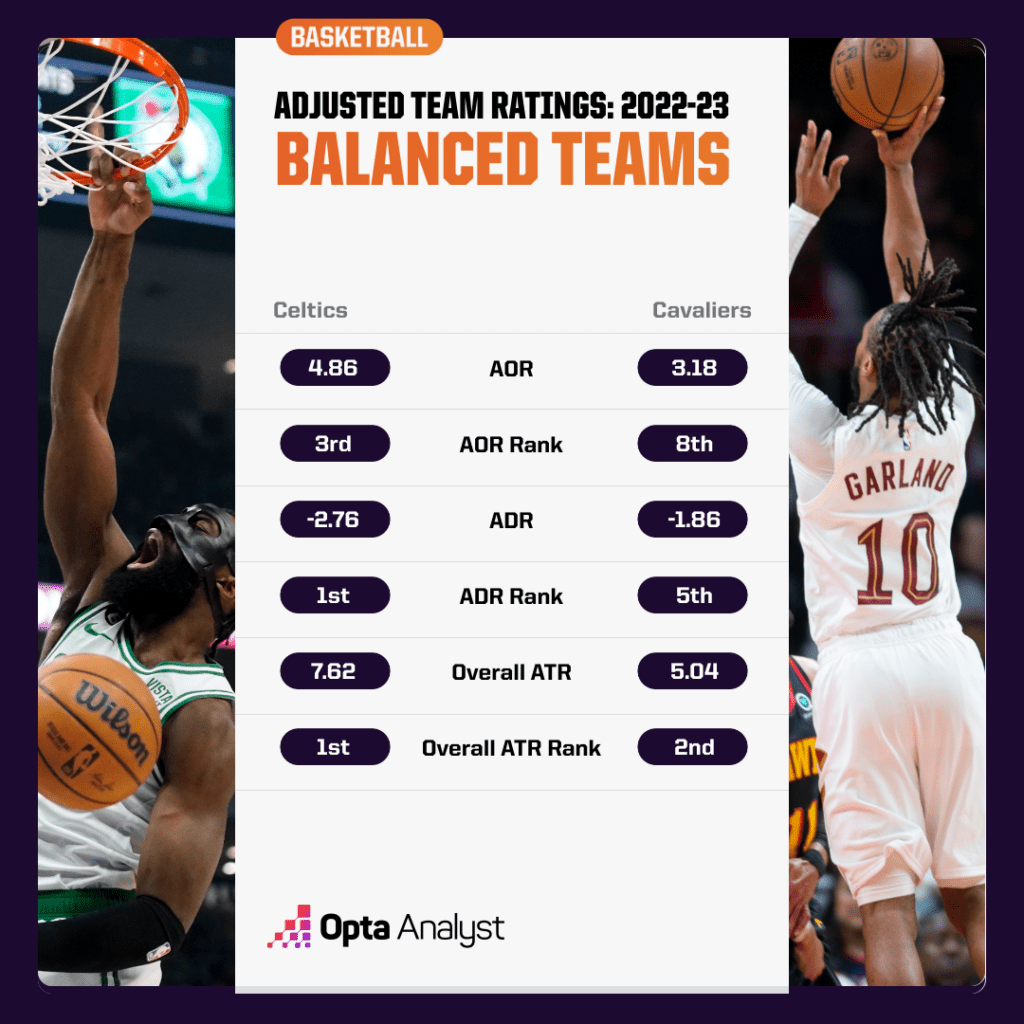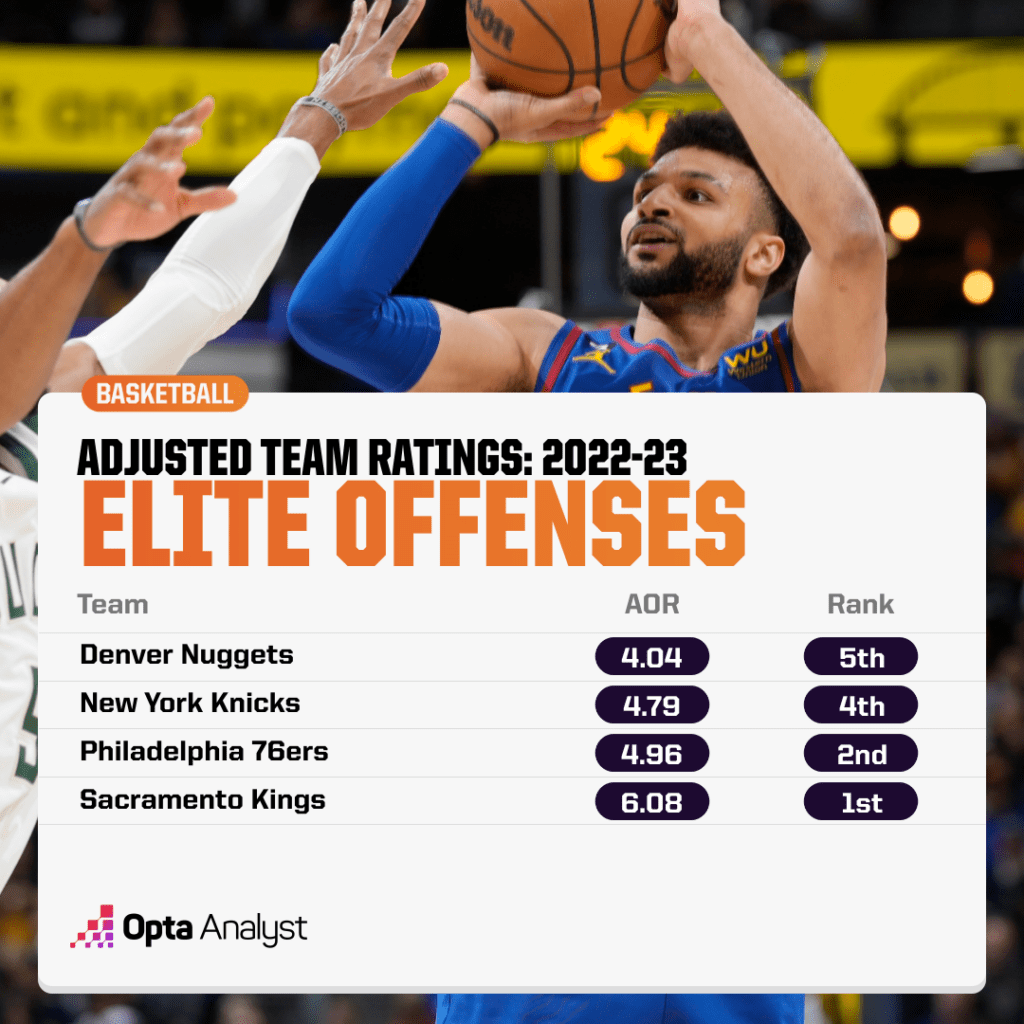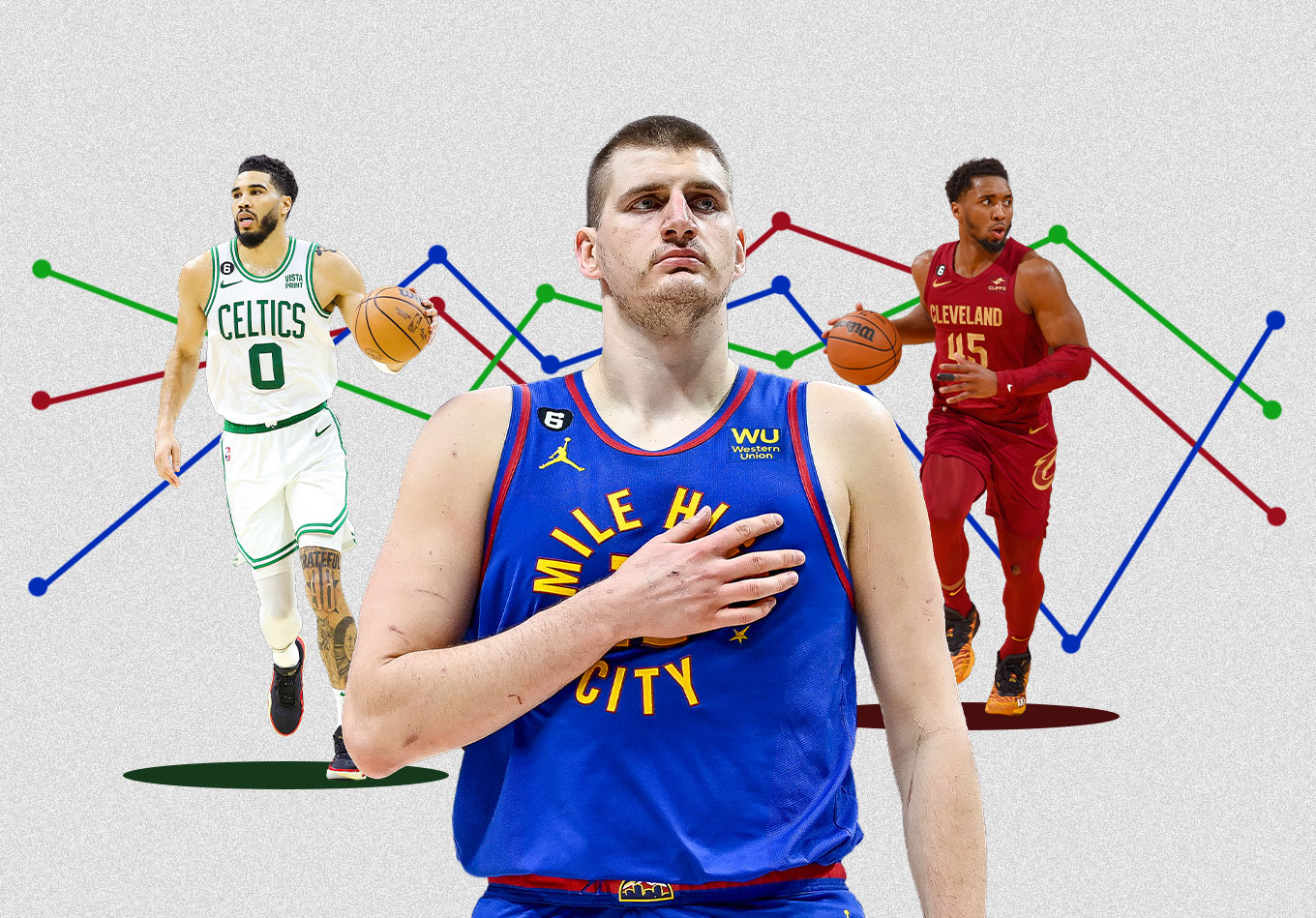At the start of the season, we ran a study seeking to identify which types of teams usually make the conference finals.
Midway through the season, we revisited this study to see which teams were shaping up to be contenders this year. And now, with the regular season almost in the books, we will reexamine the landscape of the league to see which teams look like candidates for deep runs heading into the playoffs.
What did we learn in our original study?
The abridged version of our findings goes something like this. Using our adjusted team ratings (ATR), particularly our adjusted offensive rating (AOR) and adjusted defensive rating (ADR) measures, we identified three main groups of teams that end up making the conference finals. Those groups are elite offenses, elite defenses and balanced teams.
If you want to learn more about our ATR, be sure to check out the explanatory piece. Here is a scatter plot of this year’s clubs by AOR and ADR entering the week (remember, in the case of ADR, the lower the output, the better):
Now, let’s further examine the AOR and ADR of each team to see which clubs fall under one of these three categories.
Balanced Teams
Of the 144 conference finalists that our study looked at (our ATR data goes all the way back to 1987), more teams fit this category than any other.
In fact, roughly 44.4% of conference finalists since 1987 (64 of 144 teams) fit the criteria necessary to be considered a “balanced” team. To be a balanced team, the team must have an AOR score of 1.5 or higher and an ADR of minus-1.5 or lower.
Interestingly enough, only two of our six “contenders” fit our definition of a balanced team this go around. Those teams are the Boston Celtics and Cleveland Cavaliers.

One thing you will notice in a little bit is that the Celtics also qualify for the “elite offense” group.
However, for the sake of simplicity, any team that fits more than one of the three groups is put in the balanced category.
Elite Offenses
The second most-populated group of conference finalists was the one powered by elite offenses as 46 of the 144 conference finals teams (31.9%) fit our guidelines for an elite offense.
For those wondering, the guidelines that constitute an elite offense, for the purposes of our study, are a team with an AOR of 3.5 or higher and an ADR of higher than -1.5 (because if it is lower than that, then they would be considered a “balanced” team).
This season, as one would probably expect given the monstrous offensive surge we’ve been experiencing across the league, we have more contenders who fall under the elite offense group than in any other category.
As it stands, four of our six “contenders” fall under the elite offense category (Boston would have been No. 5 had its defense not been so stout). Those four teams are the Denver Nuggets, New York Knicks (who would have ever thought we’d see a Tom Thibodeau-coached team on this list), Philadelphia 76ers and Sacramento Kings.

Elite Defenses
Those of you who are fluent in arithmetic probably deduced that because we have two balanced contenders, four elite offense contenders, and six contenders total, that must mean that we don’t have any contenders that fall under the “elite defense” group.
The people who made that inference are indeed correct.
This is a little bit strange, considering the NBA champion Golden State Warriors fell under this category last season. But then again, it isn’t completely out of the ordinary that this is happening, as elite defenses only make up 13.8% (20 of 144 teams) of conference finalists since 1987.
Plus, as we said, the NBA has experienced a huge spike in offensive efficiency this year, so it isn’t exactly the perfect time to build a contending team that is based solely on defense.
To meet the threshold of what our study defines as an elite defense, a team must have an ADR of -3.5 or less and an AOR of under 1.5 (because if it is higher than that, it would be considered a balanced team).
As you may have noticed earlier, the Celtics have the best defense in the league (man, do they look good), but even that wasn’t enough to get to that historically elite defensive level.
Fringe Contenders
In the study, we included a fourth category that made up the remaining 14 conference finals teams (9.7%) that didn’t fit in any of the three main groupings. We called these teams the “other” category.
This group exists partially because, in sports, fluky upsets happen from time to time that not even the most diligent projection methods can account for. But the main reason we have the other category is to counterbalance the arbitrary nature of our criteria for the other groups.
For instance, if we lowered the threshold for an elite offense from an AOR of 3.5 or greater to an AOR of 3.25 or greater, the Dallas Mavericks (AOR of 3.31) and Atlanta Hawks (AOR of 3.38) would both also fit under this category.
The same thing can be said about the balanced group. If, instead of 1.5, balanced teams were teams with an AOR of 1.25 or greater and an ADR of -1.25 or less, the Memphis Grizzlies, Milwaukee Bucks and Chicago Bulls would all also achieve contender status.
(Side note: The Bucks would likely fit our normal definition of a contender had they not been without Khris Middleton for the majority of the season. He’s now looking like himself again, so Milwaukee will be able to count on him in the postseason.)
The subjective definitions exist for a reason. Those cut-off points are usually what elite offenses, elite defenses and balanced teams look like. But it is also important to pay attention to those teams right on the cusp of falling into one of the three major groups.
Another variable to monitor is the seismic impact this season’s unprecedented trade deadline has had on the league hierarchy. Before the deadline, the Lakers were 25th in ATR, 21st in AOR and 20th in ADR. Now, they are 15th, 18th and 10th in those statistics, respectively. So it’s possible the group they have right now would constitute a balanced team if they started out the season together.
(Side note No. 2: The same thing can be said about the Phoenix Suns and how their midseason acquisition of Kevin Durant has changed the entire trajectory of their season.)
This year marks the first time since 2005-06 that we don’t have a single team with a point differential of plus-7 or higher (the Celtics are the closest at +6.4). This further illustrates how wide open the field is compared to prior seasons. Simply put, this season has been a wild one, so we must consider outside factors when doing our forward-looking analysis.
Still, history tends to repeat itself more often than it doesn’t, and because of that, the six teams that look more like past contenders based on our data right now (the Celtics, Cavaliers, Nuggets, Knicks, 76ers and Kings) deserve to be monitored closely.
After all, who knows, maybe in a few months, four of those six will be center stage, duking it out for the world to see in the conference finals.
